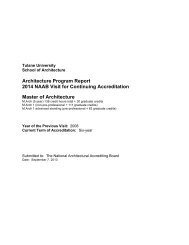Architecture Program Report Tulane University New Orleans ...
Architecture Program Report Tulane University New Orleans ...
Architecture Program Report Tulane University New Orleans ...
You also want an ePaper? Increase the reach of your titles
YUMPU automatically turns print PDFs into web optimized ePapers that Google loves.
technologies, the expanding consumer design market, event planning, design-build, real<br />
estate, and public advocacy.<br />
Developmental conditions for the practice of architecture not only support larger<br />
corporate firms that operate worldwide, with ever greater resources spent on<br />
specialization, but increasingly herald smaller firms practicing globally through the use of<br />
ever more sophisticated design and production technologies. As a result of both<br />
conditions, architects must achieve ever more sophisticated abilities in the areas of<br />
management and financial skills. Endeavoring to understand and work in different<br />
cultures is also a requirement for the future of the profession.<br />
2. Technology<br />
The impact of computer and other design technologies and media over the past decade<br />
has been nothing short of revolutionary to the practice of architecture. This has led to an<br />
emphasis on both conceptual and applied approaches to the use of technology.<br />
Precision-based design, newer forms of design, and new design techniques that would<br />
have been impossible previously are now standard in the profession. Virtual design<br />
environments have presented new venues for architectural design, whereby architects,<br />
builders and clients now have greater access to design formulation and processes. As<br />
above, the use of advanced technologies has also enabled architects to practice<br />
globally. An ever-increasing scope of efficiency in the production of design and building<br />
has also been a by-product.<br />
Through computer and design technologies and media, clients and inhabitants of<br />
buildings have come to demand greater degrees of durability, comfort, and economic<br />
performance. There has been a consequent concern for the environmental impacts<br />
made by architecture at all stages of its performance, from design through construction<br />
and eventual inhabitation. The architect must address these demands with an in-depth<br />
knowledge and commitment to new technologies and their scope of use.<br />
B. Architectural Education<br />
Architectural education in North America and globally is undergoing substantial change<br />
and redefinition. Historically, the profession expected graduates of schools of<br />
architecture to be able to assume the challenging roles of professional practice with<br />
ease. This demand has only increased over the past few decades. Recently graduated<br />
students are expected to also be broadly educated and flexible thinkers with the abilities<br />
to effectively manage complex processes and projects—in addition to the traditional<br />
knowledge gained by university education. Moreover, leadership in the profession<br />
requires heightened management and interpersonal skills—coupled with the traditional<br />
skill, knowledge and expertise of the architect.<br />
There remains a long-standing debate between the schools and the profession on their<br />
respective educational responsibilities for new professionals. For architects, a 'complete<br />
education' for admission into the profession as a licensed architect consists of a program<br />
of study in an accredited, professional degree program, internship under the supervision<br />
of a licensed architect and successful completion of the architectural registration exams.<br />
Every component of these requirements is subject to debate; in particular the role of the<br />
internship program and the registration exam remains unresolved and contentious.<br />
In addition, there are now mandates for continuing education to maintain professional<br />
registration, a situation that is creating opportunities for, and demands on, schools of<br />
architecture. It is understood that, like all professions, the rapid pace of change and














